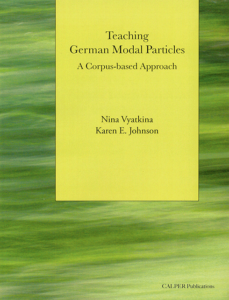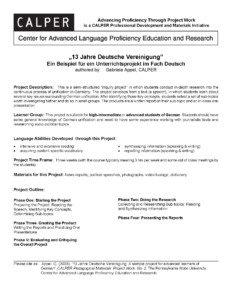Teaching German Modal Particles: A Corpus-based Approach
Teaching German Modal Particles: A Corpus-based Approach offers an approach to the challenges of teaching the usage of modal particles to learners of German that emphasizes awareness raising activities. The worksheets and handouts are sequenced to move learners through a gradual process of inductively noticing patterns of modal particle use, to defining modal particle meanings and usages, to analyzing modal particle use in context, and finally, to deductively using modal particles in extended communicative interactions. All worksheets are followed by answer keys which offer additional explanations about appropriate modal particle usage. The materials have been created on the basis of a collection of authentic communicative computer-mediated interactions that took place between L2 learners of German and native speakers of German.
Teaching German Modal Particles: A Corpus-based Approach is intended for high-intermediate and advanced levels of proficiency and can be used as supplemental materials in a variety of college/university courses.
What educators say:
“Thank you for sharing the German Modal Particles materials! I will be using them from now on with my honor society and German IV students.” Dr. Noelle Andrie, The Pennsylvania Cyber Charter School
Now available as free downloads: All worksheets, answer keys, and handout are now available as free downloadable PDFs. For educational use only. By downloading a PDF, you agree with not reposting or redistributing the materials. Please read “Preface.”

Publication Units:
Preface
A. Noticing Modal Particle Usage
A_WS1 … A_AK1
A_WS2 ….A_ AK2
B. Defining Modal Particles
B_H1
B_H2
B_H3
B_H4
B_H5
D_WS2 … D_AK2
E_WS1 … E_AK1
Publication Files:
Project Work: German
Project Work: German
13 Jahre Deutsche Vereinigung: A Sample Project for Advanced Learners of German
This group project is an “inquiry project”, in which students research in-depth the continuous process of unification in Germany. Students’ research develops from a text (a speech), which they read initially. In this speech, several key issues surrounding German unification are raised, which can be transformed into project questions or sub-topics worth investigating. After identifying key concepts, students select a set of sub-topics to be researched and do so in small groups. The product, which they develop is a written report on their sub-topic and an oral presentation. Author: Gabriela Appel, Penn State University. 2003 – See more at: http://calper.la.psu.edu/content/language-learning-projects-and-project-support-materials#sthash.0qaeOa4P.dpuf

Publication Units:
13 Jahre Deutsche Vereinigung: A Sample Project for Advanced Learners of German
This group project is an “inquiry project”, in which students research in-depth the continuous process of unification in Germany. Students’ research develops from a text (a speech), which they read initially. In this speech, several key issues surrounding German unification are raised, which can be transformed into project questions or sub-topics worth investigating. After identifying key concepts, students select a set of sub-topics to be researched and do so in small groups. The product, which they develop is a written report on their sub-topic and an oral presentation.